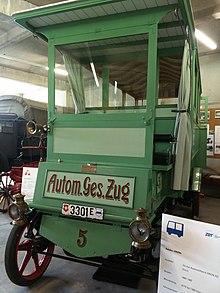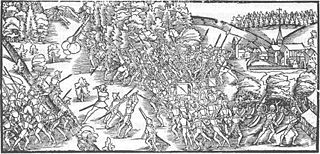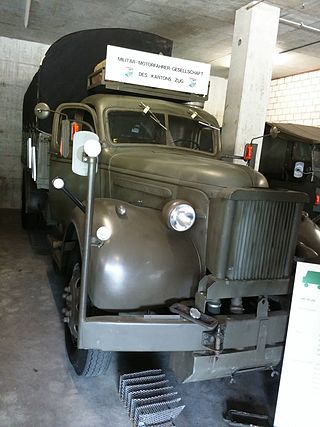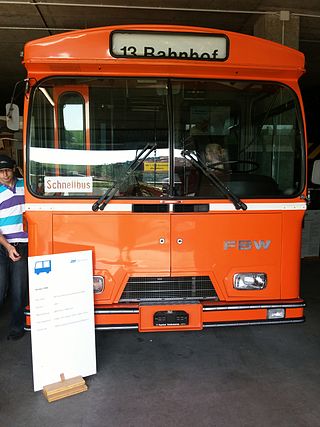
The Orion Autobus is a bus from the Swiss manufacturer "Automobile Factory Orion" from Zurich.

The Orion Autobus is a bus from the Swiss manufacturer "Automobile Factory Orion" from Zurich.
The Orion buses were built between 1899 and 1903 at the Orion factory at Zurich. They offered 12 seats for passengers. The entrance for the passenger compartment is at the rear. The vehicle is equipped with four solid rubber tires.
In August 1904, an automobile course was set up with Orion buses from the Aktiengesellschaft für Automobilverkehr im Kanton Zug from Zug via Hinterburg to Menzingen; An automobile course in the Ägerital was offered, which on 1 November 1905 took over also the post courses. The routes were extended to Zug - Baar - Menzingen and to Zug - Unterägeri - Oberägeri. However, in 1913, the tram canceled the automobile courses because the Orion buses were not yet reliable and with their solid rubber tires on the unpaved road not comfortable - the streetcar promised a quality increase. An Orion bus was stored in the Swiss Museum of Transport, it was restored by the Orion Club and since 1 April 2000 it has been an exhibit in the Zuger Depot Technikgeschichte.
| engine power | 15 kW (20 hp) at 1'000 / min. |
| Length | 5'000 mm |
| Width | 1'900 mm |
| Height | 3,100 mm |

Zug is the largest town and capital of the Swiss canton of Zug in Switzerland. Its name, translating from German as "pull" or "tug", originates from the fishing vocabulary; in the Middle Ages it referred to the right to pull up fishing nets and hence to the right to fish.

The canton of Zug or Zoug is one of the 26 cantons of Switzerland. It is located in central Switzerland and its capital is Zug. At 239 km2 (92 sq mi) the canton is one of the smallest of the Swiss cantons in terms of area. It is not subdivided into districts, but eleven municipalities.

The Second War of Kappel was an armed conflict in 1531 between the Catholic and the Protestant cantons of the Old Swiss Confederacy during the Reformation in Switzerland.
The Zug massacre took place on 27 September 2001 in the city of Zug in the canton's parliament. Friedrich Leibacher shot dead 14 people before killing himself.

Franz Brozincevic & Cie (FBW) was a Swiss maker of trucks, motorbuses and trolleybuses, founded by Croatian-born engineer and constructor Franjo (Franz) Brozinčević (1874-1933), active between 1922 and 1985 and based in Wetzikon, canton of Zürich.

The Berna L275/10 is a truck model manufactured by the Swiss company Berna from 1937 onwards. The Berna L275 / 10, military designation "Lastw gl 1.5t 4x2", has a total weight of 2200 kg, a structure with cabin and bridge as well as an on-board voltage of 6 V. The 6-cylinder petrol engine with 3600 cm³ produces a power of 66 kW (90 hp).

The Geser F-250 4x4 is a fire-fighting vehicle from Switzerland.

The Mowag W300 is a fire-fighting vehicle from Switzerland. It is a rebadged variant of the Dodge W-Series trucks.

The Magirus-Deutz Muni is a fire-fighting vehicle from Germany. Which was produced by the Ulmer commercial vehicle manufacturer Magirus-Deutz in only 6 pieces

The GMC AC 454 is a truck model that the GMC manufactured from 1940 on.

ESZ Personenwagen C 36 – C 38 was the name of three two-axle passenger cars of the electric trams in the canton of Zug (ESZ).

CFe 4/4 was the designation of the electric railcar of the Elektrische Strassenbahnen im Kanton Zug (ESZ), build by the Maschinenfabrik Oerlikon and delivered from 1913 onwards. One of the CFe 4/4 of the ESZ had the nickname "elephant".

The APE 4.80 is a passenger trailer wagon and was built by the Swiss manufacturer Gebrüder Moser + Cie and Ramseier & Jenzer + Cie, both in Bern, for the Zugerland Verkehrsbetriebe (ZVB).

The FBW 91U EU4A is a bus of the Swiss manufacturer Franz Brozincevic Wetzikon (FBW), from Wetzikon.

The Saurer 5 DUK is a bus of the Swiss manufacturer Adolph Saurer AG, from Arbon.
The Militärhistorische Stiftung des Kantons Zug MHSZ is a foundation consisting of a group of Military Museums in the canton of Zug with the purpose of safeguarding and cultivating the military heritage of the Swiss Confederation in the canton of Zug.

The Salesianum, also known as the "Pearl of Zug" or St. Karlshof, is a historic estate and mansion, located in the southernmost part of the town of Zug, Switzerland along the lake, in the direction of Oberwil.

The Oberaargau-Jura Railways was a former railway company in Switzerland. It was created in 1958 from the merger of the Langenthal-Jura Railway with the Langenthal–Melchnau-Bahn. The name refers to the Oberaargau and the Swiss Jura. The OJB changed its name to Regionalverkehr Oberaargau on 2 July 1990.

The Katastrophenbucht is a bay on Lake Zug in the city of Zug. Its name derives from a catastrophe in a shore part called Vorstadt, in which the lake shore broke on 5 July 1887 and flooded residential buildings.

For the artistic term, see trompe-l'oeil